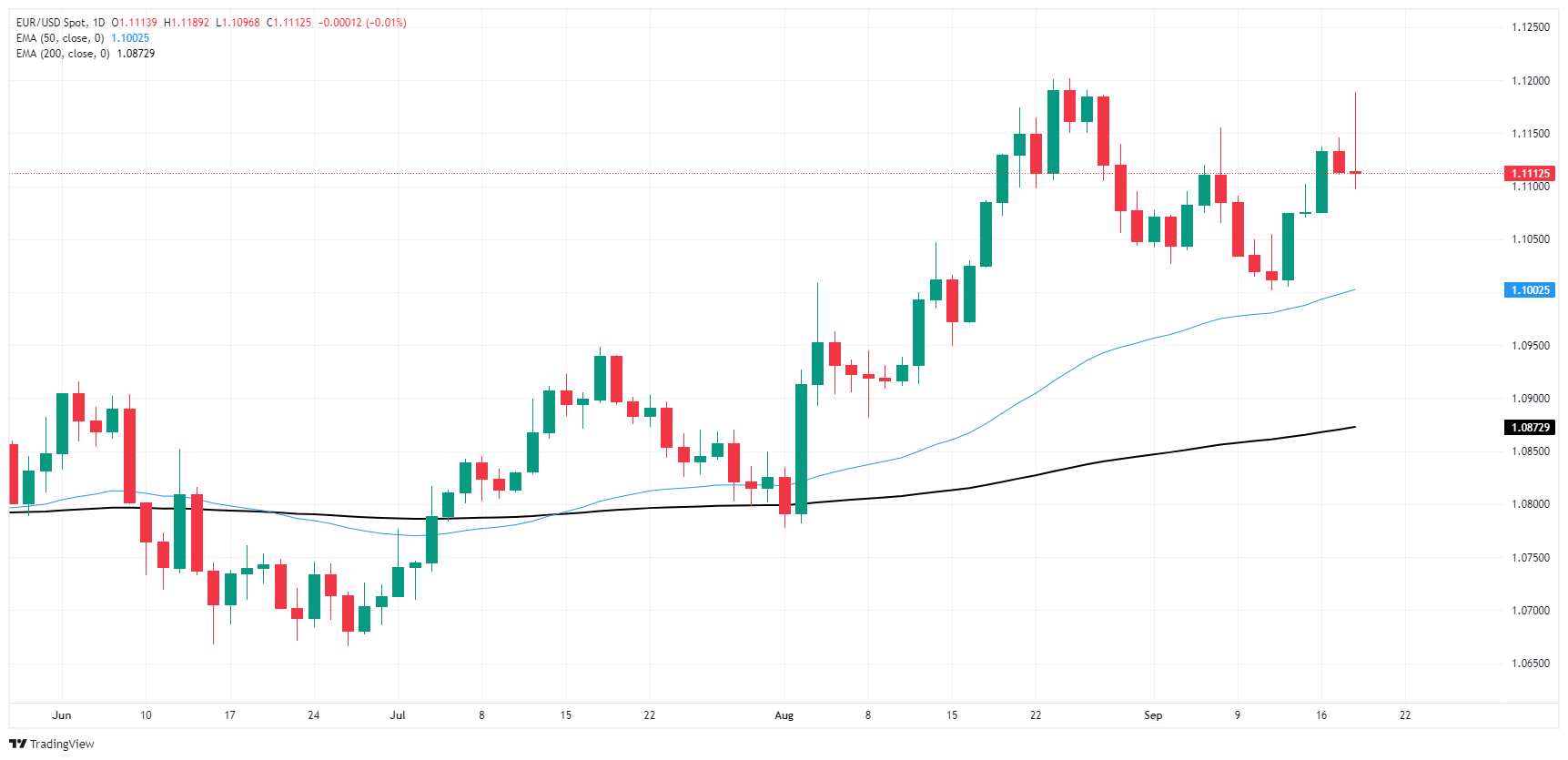EUR/USD flattens post-Fed rate cut

- EUR/USD climbed on reaction to first Fed rate cut since March of 2020.
- Fed delivers a surprise 50 bps rate cut out of the gate.
- Fed dot plot eases lower in September, unemployment forecast ticks slightly higher.
EUR/USD soared into a fresh high for September after the Federal Reserve (Fed) surprised markets with a full 50 bps rate cut on Wednesday, pushing risk appetite into the high side and sending traders scrambling for the buy button. This marks the first Fed rate cut in over four years. Following the Fed’s first rate cut since 2020, markets eased back to where they began, with Fiber settling back into the 1.1100 handle.
The Fed’s dot plot of the Federal Open Market Committee’s (FOMC) Summary of Economic Projections was also revised downward from the central bank’s previous rate outlook. The median policy expectations from the Fed now see the Fed Funds rate at 4.4% by year-end 2024 and 3.4% by year-end 2025, down from 5.1% and 4.1%, respectively.
Going deeper into the Fed’s notes, Fed policymakers now see US Gross Domestic Product (GDP) growth of 2.0% flat through 2024, down from the previous print of 2.1% in June. Fed officials also expected the US Unemployment Rate to settle around 4.4% by the end of 2024.
Fed Chair Jerome Powell did his best to soothe markets during his ensuing press conference following the Fed’s bumper 50 bps rate trim, highlighting that the Fed will resume its wait-and-see approach to incoming economic data in the weeks to come before deciding on further rate cuts. The Fed head’s measured approach to explaining the Fed’s policy adjustment helped to keep market flows on-balance, and rate markets are pricing in 65% chance of no further action at the FOMC’s next rate call on November 7.
EUR/USD price forecast
Despite Wednesday’s Fed-fueled intraday rally, EUR/USD continues to churn near the 1.1100 handle. The post-Fed rally toward 1.1200 reversed course in short order, and Fiber has chalked in a flat day for the midweek session. The pair is still cycling chart paper on the high end of recent momentum, and short pressure will have a difficult time staging a full pullback to the 50-day Exponential Moving Average (EMA) near 1.1000.
EUR/USD daily chart
Euro FAQs
The Euro is the currency for the 20 European Union countries that belong to the Eurozone. It is the second most heavily traded currency in the world behind the US Dollar. In 2022, it accounted for 31% of all foreign exchange transactions, with an average daily turnover of over $2.2 trillion a day. EUR/USD is the most heavily traded currency pair in the world, accounting for an estimated 30% off all transactions, followed by EUR/JPY (4%), EUR/GBP (3%) and EUR/AUD (2%).
The European Central Bank (ECB) in Frankfurt, Germany, is the reserve bank for the Eurozone. The ECB sets interest rates and manages monetary policy. The ECB’s primary mandate is to maintain price stability, which means either controlling inflation or stimulating growth. Its primary tool is the raising or lowering of interest rates. Relatively high interest rates – or the expectation of higher rates – will usually benefit the Euro and vice versa. The ECB Governing Council makes monetary policy decisions at meetings held eight times a year. Decisions are made by heads of the Eurozone national banks and six permanent members, including the President of the ECB, Christine Lagarde.
Eurozone inflation data, measured by the Harmonized Index of Consumer Prices (HICP), is an important econometric for the Euro. If inflation rises more than expected, especially if above the ECB’s 2% target, it obliges the ECB to raise interest rates to bring it back under control. Relatively high interest rates compared to its counterparts will usually benefit the Euro, as it makes the region more attractive as a place for global investors to park their money.
Data releases gauge the health of the economy and can impact on the Euro. Indicators such as GDP, Manufacturing and Services PMIs, employment, and consumer sentiment surveys can all influence the direction of the single currency. A strong economy is good for the Euro. Not only does it attract more foreign investment but it may encourage the ECB to put up interest rates, which will directly strengthen the Euro. Otherwise, if economic data is weak, the Euro is likely to fall. Economic data for the four largest economies in the euro area (Germany, France, Italy and Spain) are especially significant, as they account for 75% of the Eurozone’s economy.
Another significant data release for the Euro is the Trade Balance. This indicator measures the difference between what a country earns from its exports and what it spends on imports over a given period. If a country produces highly sought after exports then its currency will gain in value purely from the extra demand created from foreign buyers seeking to purchase these goods. Therefore, a positive net Trade Balance strengthens a currency and vice versa for a negative balance.
